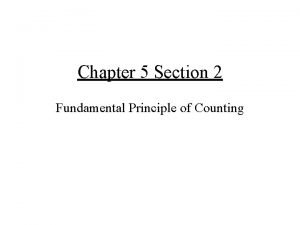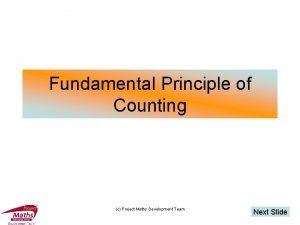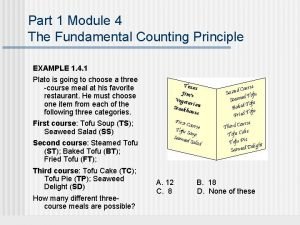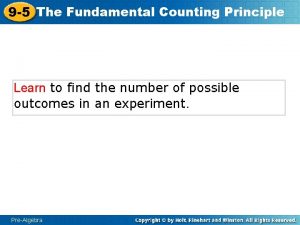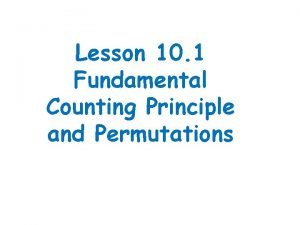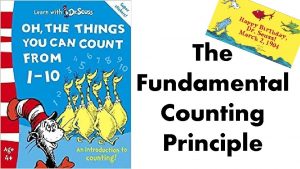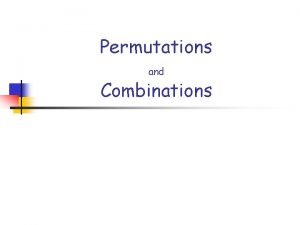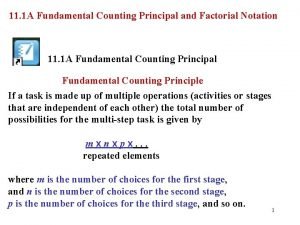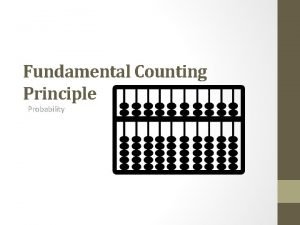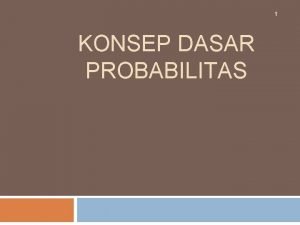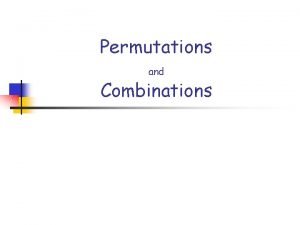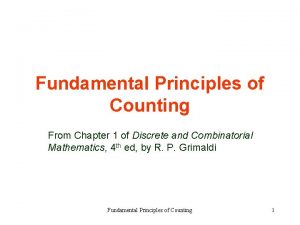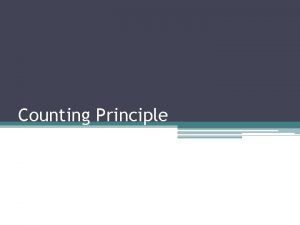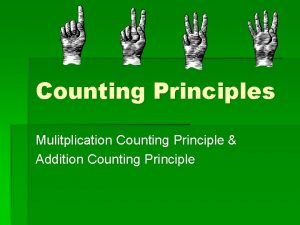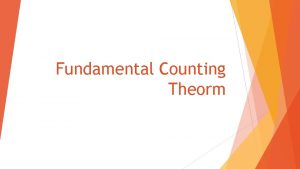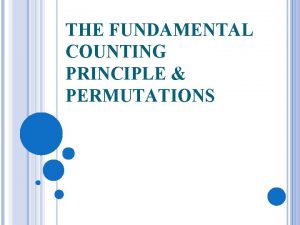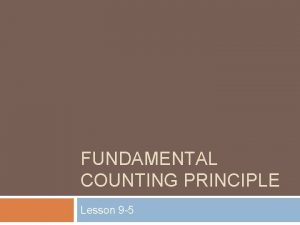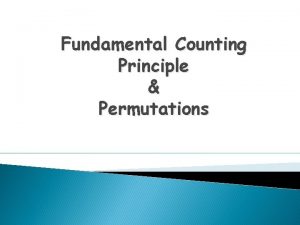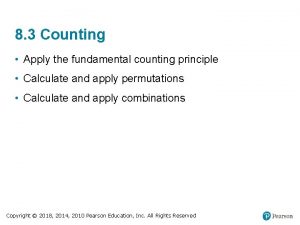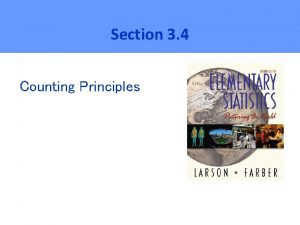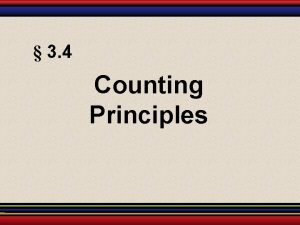9 5 The Fundamental Counting Principle Learn to














- Slides: 14

9 -5 The Fundamental Counting Principle Learn to find the number of possible outcomes in an experiment. Pre-Algebra

9 -5 The Fundamental Counting Principle Pre-Algebra

9 -5 The Fundamental Counting Principle Example 1 A: Using the Fundamental Counting Principal License plates are being produced that have a single letter followed by three digits. All license plates are equally likely. A. Find the number of possible license plates. Use the Fundamental Counting Principle. letter first digit second digit third digit 26 choices 10 choices 26 • 10 = 26, 000 The number of possible 1 -letter, 3 -digit license plates is 26, 000. Pre-Algebra

9 -5 The Fundamental Counting Principle Example 1 B: Using the Fundamental Counting Principal B. Find the probability that a license plate has the letter Q. P(Q Pre-Algebra 1 ) = 1 • 10 = ≈ 0. 038 26, 000 26

9 -5 The Fundamental Counting Principle Example 1 C: Using the Fundamental Counting Principle C. Find the probability that a license plate does not contain a 3. First use the Fundamental Counting Principle to find the number of license plates that do not contain a 3. 26 • 9 • 9 = 18, 954 possible license plates without a 3 There are 9 choices for any digit except 3. P(no 3) = 18, 954 = 0. 729 26, 000 Pre-Algebra

9 -5 The Fundamental Counting Principle tells you only the number of outcomes in some experiments, not what the outcomes are. A tree diagram is a way to show all of the possible outcomes. Pre-Algebra

9 -5 The Fundamental Counting Principle Example 2: Using a Tree Diagram You have a photo that you want to mat and frame. You can choose from a blue, purple, red, or green mat and a metal or wood frame. Describe all of the ways you could frame this photo with one mat and one frame. You can find all of the possible outcomes by making a tree diagram. There should be 4 • 2 = 8 different ways to frame the photo. Pre-Algebra

9 -5 The Fundamental Counting Principle Example 2 Continued Each “branch” of the tree diagram represents a different way to frame the photo. The ways shown in the branches could be written as (blue, metal), (blue, wood), (purple, metal), (purple, wood), (red, metal), (red, wood), (green, metal), and (green, wood). Pre-Algebra

9 -5 The Fundamental Counting Principle Pre-Algebra

9 -5 The Fundamental Counting Principle Try This: Example 1 Social Security numbers contain 9 digits. All Social Security numbers are equally likely. A. Find the number of possible Social Security numbers. Use the Fundamental Counting Principle. Digit 1 2 3 4 5 6 7 8 9 Choices 10 10 10 • 10 • 10 = 1, 000, 000 The number of Social Security numbers is 1, 000, 000. Pre-Algebra

9 -5 The Fundamental Counting Principle Try This: Example 1 B B. Find the probability that the Social Security number contains a 7. P(7 _ _ _ _) = 1 • 10 • 10 1, 000, 000 = Pre-Algebra 1 = 0. 1 10

9 -5 The Fundamental Counting Principle Try This: Example 1 C C. Find the probability that a Social Security number does not contain a 7. First use the Fundamental Counting Principle to find the number of Social Security numbers that do not contain a 7. P(no 7 _ _ _ _) = 9 • 9 • 9 1, 000, 000 P(no 7) = Pre-Algebra 387, 420, 489 ≈ 0. 4 1, 000, 000

9 -5 The Fundamental Counting Principle Try This: Example 2 A baker can make yellow or white cakes with a choice of chocolate, strawberry, or vanilla icing. Describe all of the possible combinations of cakes. You can find all of the possible outcomes by making a tree diagram. There should be 2 • 3 = 6 different cakes available. Pre-Algebra

9 -5 The Fundamental Counting Principle Try This: Example 2 yellow cake chocolate icing vanilla icing strawberry icing white cake chocolate icing vanilla icing strawberry icing Pre-Algebra The different cake possibilities are (yellow, chocolate), (yellow, strawberry), (yellow, vanilla), (white, chocolate), (white, strawberry), and (white, vanilla).
 Ncr formula
Ncr formula Counting principle definition
Counting principle definition What is the fundamental principle of counting
What is the fundamental principle of counting Fundamental couting principle
Fundamental couting principle Tree diagram outcomes
Tree diagram outcomes Fundamental
Fundamental Permutations
Permutations Fundamental counting principle
Fundamental counting principle Counting principle, permutations and combinations
Counting principle, permutations and combinations Fundamental counting principle and factorial notation
Fundamental counting principle and factorial notation Tree diagram counting techniques
Tree diagram counting techniques Prinsip menghitung probabilitas
Prinsip menghitung probabilitas Combination equation
Combination equation Fundamental principles of counting
Fundamental principles of counting When employing the fundamental counting rule
When employing the fundamental counting rule

